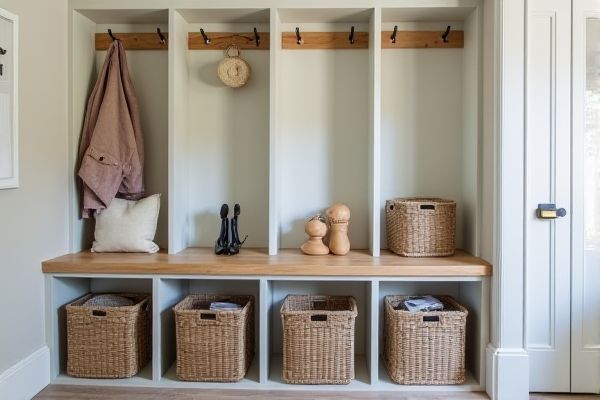
Stackable bins optimize vertical space by securely piling items, ideal for maximizing your mudroom storage efficiency, while nesting bins save floor space by fitting inside each other when not in use, offering flexible storage solutions. Explore the full article to discover which bin type suits your mudroom organization needs best.
Table of Comparison
| Feature | Mudroom Stackable Bins | Nesting Bins |
|---|---|---|
| Design | Rigid structure with interlocking edges for stacking | Designed to slide inside each other to save space |
| Space Efficiency | Maximizes vertical storage, ideal for small spaces | Minimizes storage footprint when empty |
| Capacity | Holds larger volumes; stable for heavy items | Varies by bin size; less stable when stacked |
| Durability | Typically made from heavy-duty plastic or metal | Usually lightweight plastic; less sturdy under heavy load |
| Usage | Ideal for organizing shoes, outerwear, and gear | Great for seasonal storage and general decluttering |
| Portability | Stacked bins can be bulky but secure | Easy to carry individually or nested |
| Price Range | Moderate to high due to heavy-duty materials | Generally lower cost and more affordable |
Introduction to Mudroom Storage Solutions
Mudroom stackable bins offer a space-efficient storage option by maximizing vertical space and allowing easy access to your items, ideal for organizing shoes, gloves, and small accessories. Nesting bins provide a flexible solution that saves room when not in use by fitting compactly inside one another, perfect for seasonal or infrequent storage needs. Choosing between stackable and nesting bins depends on your mudroom layout and how frequently you need to access your belongings.
What Are Stackable Bins?
Stackable bins are designed with flat, sturdy lids and interlocking edges that allow multiple containers to be securely piled on top of each other, maximizing vertical storage space in a mudroom. These bins are ideal for organizing shoes, outdoor gear, and seasonal items, enabling easy access while maintaining a neat, compact footprint. Their rigid structure and stack-friendly design make them a practical solution for tight spaces that require efficient use of height.
What Are Nesting Bins?
Nesting bins are designed to fit one inside another when not in use, saving space and making storage more efficient in your mudroom. These bins typically have tapered sides and lack handles, allowing them to stack tightly and neatly without taking up extra room. Unlike stackable bins, nesting bins prioritize compact storage over vertical stacking, ideal for those seeking to maximize floor space and reduce clutter.
Space Efficiency: Stackable vs. Nesting Bins
Stackable bins maximize vertical space by securely piling on top of each other, making them ideal for narrow mudrooms or limited floor areas. Nesting bins save storage space when not in use by fitting inside one another, which is perfect for seasonal organization or occasional decluttering. Your choice depends on whether you value consistent, compact storage or flexible, collapsible options for varied needs.
Accessibility and Organization
Stackable bins maximize vertical space, allowing your mudroom to stay organized while keeping items easily accessible through clear or labeled front faces. Nesting bins save storage space when not in use by fitting inside one another, but may require more effort to retrieve individual bins. Choosing between these bins depends on whether you prioritize quick, visible access or compact storage efficiency for your mudroom organization.
Durability and Material Choices
Stackable mudroom bins are typically made from heavy-duty plastic or metal, offering superior durability and the ability to withstand frequent handling and heavy loads. Nesting bins, often crafted from lighter plastic or fabric, prioritize space-saving but may sacrifice long-term durability under constant use. Choosing the right material for your mudroom storage ensures your bins maintain structural integrity and functionality over time.
Aesthetics and Design Options
Stackable bins in mudrooms offer a sleek, uniform appearance ideal for modern, minimalist designs, maximizing vertical space while maintaining visual order. Nesting bins provide versatile design options with varied shapes and sizes that can be stored compactly when not in use, enabling dynamic, customizable organization tailored to different decor styles. Both options enhance mudroom aesthetics by balancing function with clean, structured storage solutions suitable for contemporary and traditional interiors.
Cost Comparison: Stackable vs. Nesting Bins
Stackable bins for mudrooms generally come at a higher upfront cost due to their durable materials and modular design, which provides convenient vertical storage and easy accessibility. Nesting bins, on the other hand, are typically more budget-friendly because they are designed to fit inside one another when empty, saving space and reducing materials used in production. When considering your mudroom organization, nesting bins offer a cost-effective solution for seasonal storage, while stackable bins add value through long-term durability and ease of use.
Best Uses for Each Bin Type in the Mudroom
Stackable bins in the mudroom are ideal for maximizing vertical space while keeping items like shoes, gloves, and hats organized and easily accessible. Nesting bins work best for seasonal storage, as they can be compactly stored when not in use and expanded for sorting bulkier gear such as winter coats or sports equipment. Choosing between stackable and nesting bins depends on whether the primary goal is daily accessibility or efficient off-season storage.
Choosing the Right Bin Solution for Your Mudroom
Stackable bins provide vertical storage efficiency, ideal for maximizing limited floor space in mudrooms by allowing items to be easily visible and accessible. Nesting bins save space when not in use by fitting inside one another, offering flexible storage for seasonal or infrequently used items. Selecting between stackable and nesting bins depends on your mudroom's available space, frequency of access, and the types of items you need to organize.
 homyna.com
homyna.com